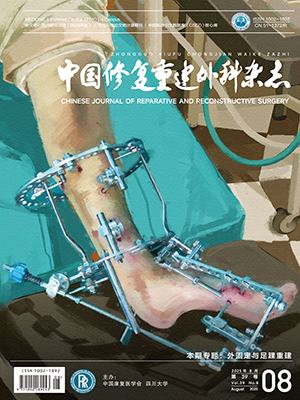Objective To investigate the effects of in-vitro monolayer culture and three-dimensional (3-D) alginate microsphere culture on the differentiation of normal human nucleus pulposus cells (NPCs), and to discuss the regulatory mechanism of restoring the phenotype of dedifferentiated NPCs by culturing resveratrol (RES) in 3-D alginate microsphere. Methods Normal human nucleus pulposus tissues were harvested for culture and identification of NPCs from 6 patients with burst lumbar vertebra fracture. NPCs at passages 1, 3, 5, and 7 in the in-vitro monolayer culture were harvested to observe the morphology, cell aging, and proteoglycan expression. The cell proliferation rates of NPCs at passage 1 in-vitro in monolayer culture and in 3-D alginate microsphere culture were detected. NPCs at passage 7 were randomly divided into 3-D alginate microsphere control group (group A), RES group (group B), silent mating type information regulation 2 homolog 1 (SIRT1)- small interfering RNA (siRNA) + RES group (group C), and negative control-siRNA + RES group (group D); and NPCs in the in-vitro monolayer culture was monolayer control group (group E). After corresponding treatment, Western blot was used for determining the protein expressions of SIRT1, Aggrecan, and collagen type II; real-time fluorescence quantitative PCR was used for detecting SIRT1 mRNA expression. Results The cultured cells were identified to be NPCs. Morphological observation, senescence-associated β-galactosidase (SA-β-gal) staining, and toluidine blue staining showed that dedifferentiation of normal NPCs tended to occur under continuous in-vitro monolayer culture, which was more obvious with increase of passage number. NPCs in 3-D alginate microsphere culture showed significantly lower proliferation rate than NPCs in the in-vitro monolayer culture (P lt; 0.05), but it could significantly improve the protein expressions of collagen type II and Aggrecan in dedifferentiated NPCs, showing significantly difference between groups E and A (P lt; 0.05). The protein expressions of SIRT1, collagen type II, and Aggrecan in group B were significantly improved when compared with that in group A (P lt; 0.05). Real-time fluorescence quantitative PCR and Western blot showed that the expressions of SIRT1 mRNA and proteins in group C were significantly inhibited after transfected with SIRT1-siRNA when compared with those in groups B and D (P lt; 0.05), and the protein expressions of collagen type II and Aggrecan in group C were significantly lower than those in groups B and D (P lt; 0.05). Conclusion Continuous in-vitro monolayer culture could efficiently cultivate numerous seeding NPCs, but it is liable to dedifferentiate. In 3-D alginate microsphere culture, RES could restore the phenotype of dedifferentiated NPCs and synthesize more extracellular matrix, which is related to the regulation of SIRT1.
Citation: SHEN Jieliang,HU Zhenming,ZHONG Xiaoming,WANG Dawu,XU Linfei.. RESTORING PHENOTYPE OF DEDIFFERENTIATED NORMAL NUCLEUS PULPOSUS CELLS BY RESVERATROL. Chinese Journal of Reparative and Reconstructive Surgery, 2013, 27(5): 547-553. doi: 10.7507/1002-1892.20130122 Copy
Copyright © the editorial department of Chinese Journal of Reparative and Reconstructive Surgery of West China Medical Publisher. All rights reserved




